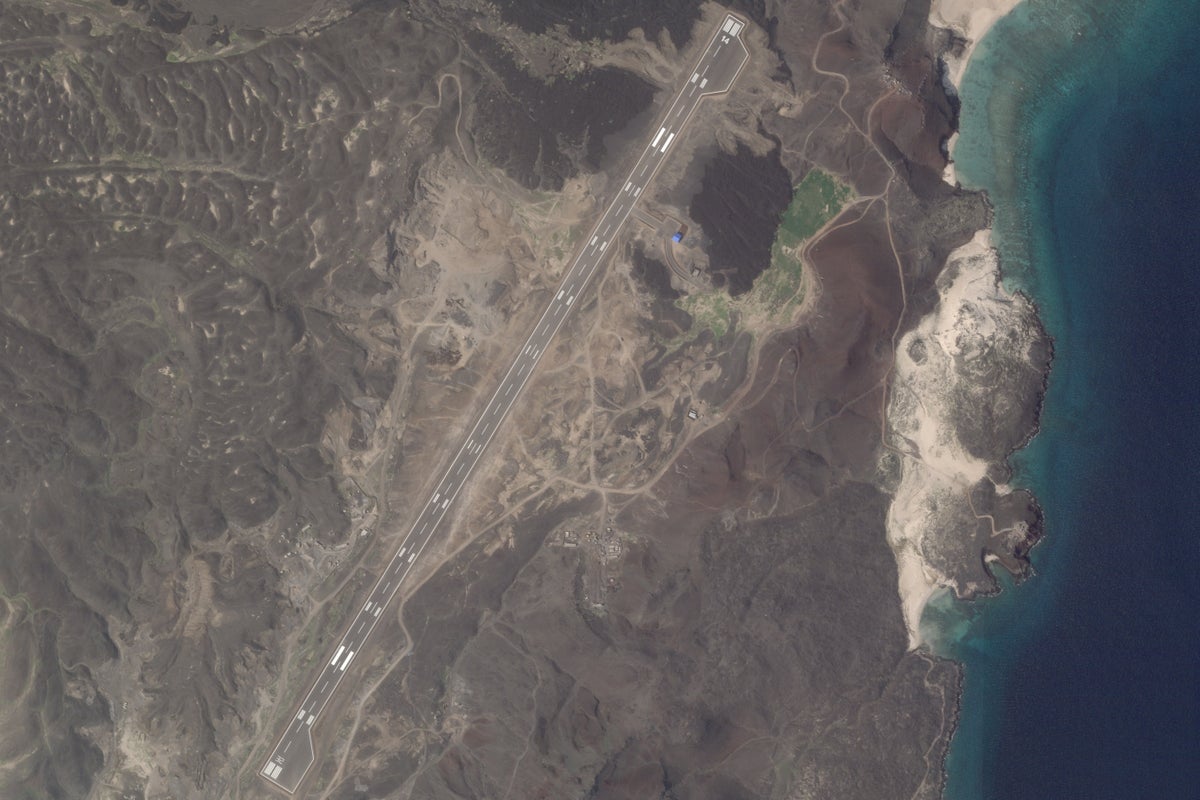
Satellite imagery has revealed the construction of a new airstrip on Zuqar Island, a volcanic outcrop in the Red Sea off Yemen’s coast. This development is believed to be the latest project by forces aligned against the country’s Iranian-backed Houthi rebels.
The facility adds another crucial link to a growing network of offshore military bases in a region vital for global shipping. Houthi militants have already attacked over 100 vessels, sinking four and causing at least nine mariner deaths amid the Israel-Hamas conflict.
Such an airstrip could grant a military power extensive aerial surveillance capabilities across the Red Sea, the Gulf of Aden, and the strategically narrow Bab el-Mandeb Strait, connecting these waterways between East Africa and the Arabian Peninsula. However, the precise trigger for its potential military deployment remains unknown.
Requests for comment from the United Arab Emirates, known for constructing similar regional runways, went unanswered. Yemen’s anti-Houthi factions, fragmented by internal conflicts and unable to mount a unified assault despite intense American and Israeli bombing campaigns targeting the rebels, also declined to respond.
In recent months, the anti-Houthi forces have been able to interdict more cargo bound for the Houthis, something that having a presence on Zuqar could aid.
“The possibility of a new Yemeni offensive against the Houthis, backed by the Saudi-led coalition, can’t be ruled out, although I don’t see it as approaching,” said Eleonora Ardemagni, an analyst at the Italian Institute for International Political Studies who long has studied Yemen.
“There’s a more important point in my view regarding the build up in Zuqar: the countering of Houthis’ smuggling activities, with particular regard to weapons,” she said.
A runway on a strategic island
Satellite photos from Planet Labs PBC analyzed by The Associated Press show the construction of a nearly 2,000-meter (6,560-foot) runway on Zuqar Island, which is some 90 kilometres (55 miles) southeast of the Houthi-held port city of Hodeida, a key shipping hub.
The images show work began in April to build out a dock on the island, then land clearing along the site of the runway. By late August, what appears to be asphalt was being laid across the runway. Images from October show the work continuing, with runway markings painted on in the middle of the month.
No one has claimed the construction. However, ship-tracking data analysed by the AP show the Batsa, a Togolese-flagged bulk carrier registered to a Dubai-based maritime firm, spent nearly a week alongside the new dock at Zuqar Island after coming from Berbera in Somaliland, the site of a DP World port. DP World declined to comment.
A Dubai-based maritime company, Saif Shipping and Marine Services, acknowledged receiving an order to deliver the asphalt to the island likely used in the airstrip’s construction on behalf of other UAE-based firms. Other Emirates-based maritime firms have been associated with other airstrip construction projects in Yemen later tied back to the UAE.
The UAE is believed to be behind multiple runway projects in recent years in Yemen. In Mocha on the Red Sea, a project to extend that city’s airport now allows it to land far larger aircraft. Local officials attributed that project to the UAE, a federation of seven sheikhdoms, including Abu Dhabi and Dubai. There is also now a runway in nearby Dhubab.
Another runway is on Abd al-Kuri Island, in the Indian Ocean near the mouth of the Gulf of Aden. And in the Bab el-Mandeb Strait itself, another runway built by the UAE is on Mayun Island. An anti-Houthi secessionist force in Yemen known as the Southern Transitional Council, which has long been backed by the UAE, controls the island and has acknowledged the UAE’s role in building the airport.
Targeting of Houthi shipments
Zuqar Island is a strategic location in the Red Sea. Eritrea captured the island in 1995 after battling Yemeni forces. An international court in 1998 placed the island formally into Yemen’s custody.
The island again found itself engulfed by war after the Houthis seized Yemen’s capital, Sanaa, in 2014 and began a march south, when the rebels took Zuqar.
Saudi Arabia and the UAE entered the war in 2015 on behalf of the country’s exiled government, stopping the Houthi advance. They also beat back the Houthis from Zuqar, retaking the island, which has become a staging ground for naval forces loyal to Tariq Saleh, a nephew of Yemen’s late strongman leader Ali Abdullah Saleh.
The younger Saleh, once allied to the Houthis before his uncle switched sides and the rebels killed him, has been backed by the UAE.
Since then, the front lines of the war have been static for years.
What changed was the Houthis’ taking their campaign globally with attacks on ships in the Red Sea and the Gulf of Aden. That continued even after a weeks-long campaign of intense airstrikes known as Operation Rough Rider launched by the United States and continued strikes by Israel, which appear to be getting closer to the Houthis’ top leadership despite the rebels’ penchant for secrecy.
“The Houthis, like any insurgent group, win by not losing,” wrote Gregory D. Johnsen, a Yemen expert, in June. “It is how the group has survived and grown from each of its wars.”
While a loose confederation of anti-Houthi groups exists, it remains fragmented and did not launch any attacks during the U.S. airstrikes. But the growing network of air bases around Yemen comes as anti-Houthi forces have made several significant seizures of weapons, likely bound for the rebels — including one large haul that was praised by the U.S. military’s Central Command.
“A likely Emirati airstrip in Zuqar could serve to improve surveillance and monitoring off the Hodeida coast to better support Yemeni forces in tackling smuggling,” Ardemagni said.
